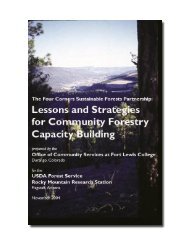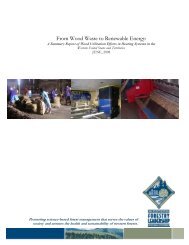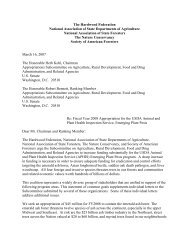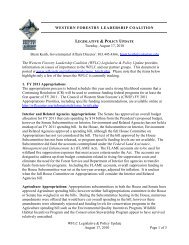Emission Controls for Small Wood-Fired Boilers - Western Forestry ...
Emission Controls for Small Wood-Fired Boilers - Western Forestry ...
Emission Controls for Small Wood-Fired Boilers - Western Forestry ...
Create successful ePaper yourself
Turn your PDF publications into a flip-book with our unique Google optimized e-Paper software.
3.2.2 MERCURY EMISSIONS<br />
Mercury emissions are typically considered with coal projects. Mercury emissions have been considered<br />
<strong>for</strong> wood combustion projects, but to a lesser extent. There is much in<strong>for</strong>mation about mercury control<br />
from coal fired power plants via fuel and exhaust cleaning. Unlike NO 2 emissions, Mercury emissions are<br />
a function of fuel mercury content. There<strong>for</strong>e, a fuel analysis provides a good indication of potential<br />
mercury emissions.<br />
Mentz et al, describes work per<strong>for</strong>med to measure mercury content of bark and stemwood in 30<br />
locations throughout the country. 1 The average bark and stemwood concentrations at the 30 sites were<br />
1.42 lb/10 12 Btu and 0.28 lb/10 12 Btu <strong>for</strong> bark and stemwood respectively. The mean mercury content <strong>for</strong><br />
each of the 30 sites ranged from 0.57 lb/10 12 Btu to 3.14 lb/10 12 Btu in bark and from 0.12 lb/10 12 Btu to<br />
0.46 lb/10 12 Btu in stemwood.<br />
These numbers are based on the assumption that the entire quantify of mercury is released from the fuel<br />
into a vapor <strong>for</strong>m and does not combine with any other constituents in the exhaust gas or is removed by<br />
some <strong>for</strong>m of emission control.<br />
Pease et al, describes research per<strong>for</strong>med to evaluate the potential <strong>for</strong> flue gas cooling, flue gas<br />
humidification, pulsed energization, and sorbent injection in wet and dry ESPs to reduce mercury<br />
emissions. This study found that all of these measures are effective. It also found that some mercury will<br />
attach to fly ash thereby increasing the potential <strong>for</strong> mercury removal.<br />
4.0 BEST MANAGEMENT PRACTICES (BMPS)<br />
BMPs range from physical equipment such as oxygen sensors to operational practices such as visual<br />
observations of plume opacity. Properly implemented, BMPs will optimize combustion conditions<br />
thereby helping maximize energy efficiency and minimize emissions from any system.<br />
4.1 Fuel Quality<br />
The first step in implementing BMPs is to obtain the highest quality fuel possible. There are many factors<br />
affecting fuel quality. Fuel quality is an important consideration as improved fuel quality improves<br />
combustion conditions, increases efficiency and reduces emissions. Fuel quality is a function of fuel<br />
moisture content, bark content, uni<strong>for</strong>mity, size, and purity. These factors are described in detail later in<br />
this report.<br />
There are no <strong>for</strong>mally established grades of wood chips. However, there are four basic types of wood<br />
chips, whose quality and corresponding emissions are fairly well understood. For the purposes of this<br />
report, the term “high quality” describes a chip which has minimal ash content, is of uni<strong>for</strong>m and proper<br />
size and results in the least possible emissions.<br />
1. Sawmill residue chips (mill chips). This chip is thought to be the highest quality in that it<br />
contains no bark. The availability of this chip is limited due to the decline in U.S. sawmills<br />
coupled with the demand <strong>for</strong> higher value products from those chips such as pulp, wood<br />
composite products and wood pellets.<br />
2. Bole tree chips (bole chips). Are produced by chipping the tree stem (trunk). This is a<br />
moderate to high quality chip as it contains relatively minimal quantities of bark and are<br />
relatively uni<strong>for</strong>m in size.<br />
1<br />
Karen Mentz, John Pinkerton, and Jeff Louch.“Potential Mercury and Hydrochloric Acid <strong>Emission</strong>s from <strong>Wood</strong> Fuels.” Forest Products<br />
Journal, 55(2): 46‐50. Received <strong>for</strong> publication in August, 2004. Article No. 9919.<br />
Resource Systems Group, Inc.<br />
<strong>Emission</strong> Control Technologies <strong>for</strong> <strong>Small</strong> <strong>Wood</strong>‐<strong>Fired</strong> <strong>Boilers</strong><br />
6 May 2010 Page 10










